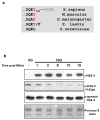WSTF regulates the H2A.X DNA damage response via a novel tyrosine kinase activity
- PMID: 19092802
- PMCID: PMC2854499
- DOI: 10.1038/nature07668
WSTF regulates the H2A.X DNA damage response via a novel tyrosine kinase activity
Abstract
DNA double-stranded breaks present a serious challenge for eukaryotic cells. The inability to repair breaks leads to genomic instability, carcinogenesis and cell death. During the double-strand break response, mammalian chromatin undergoes reorganization demarcated by H2A.X Ser 139 phosphorylation (gamma-H2A.X). However, the regulation of gamma-H2A.X phosphorylation and its precise role in chromatin remodelling during the repair process remain unclear. Here we report a new regulatory mechanism mediated by WSTF (Williams-Beuren syndrome transcription factor, also known as BAZ1B)-a component of the WICH complex (WSTF-ISWI ATP-dependent chromatin-remodelling complex). We show that WSTF has intrinsic tyrosine kinase activity by means of a domain that shares no sequence homology to any known kinase fold. We show that WSTF phosphorylates Tyr 142 of H2A.X, and that WSTF activity has an important role in regulating several events that are critical for the DNA damage response. Our work demonstrates a new mechanism that regulates the DNA damage response and expands our knowledge of domains that contain intrinsic tyrosine kinase activity.
Figures







Similar articles
-
Dual recognition of phosphoserine and phosphotyrosine in histone variant H2A.X by DNA damage response protein MCPH1.Proc Natl Acad Sci U S A. 2012 Sep 4;109(36):14381-6. doi: 10.1073/pnas.1212366109. Epub 2012 Aug 20. Proc Natl Acad Sci U S A. 2012. PMID: 22908299 Free PMC article.
-
Histone H2A.X Tyr142 phosphorylation: a novel sWItCH for apoptosis?DNA Repair (Amst). 2009 Jul 4;8(7):873-6. doi: 10.1016/j.dnarep.2009.04.003. Epub 2009 May 14. DNA Repair (Amst). 2009. PMID: 19446503
-
Phosphorylation of Williams syndrome transcription factor by MAPK induces a switching between two distinct chromatin remodeling complexes.J Biol Chem. 2009 Nov 20;284(47):32472-82. doi: 10.1074/jbc.M109.009738. Epub 2009 Sep 23. J Biol Chem. 2009. Retraction in: J Biol Chem. 2013 Oct 18;288(42):30508. doi: 10.1074/jbc.A109.009738. PMID: 19776015 Free PMC article. Retracted.
-
WSTF does it all: a multifunctional protein in transcription, repair, and replication.Biochem Cell Biol. 2011 Feb;89(1):12-23. doi: 10.1139/O10-114. Biochem Cell Biol. 2011. PMID: 21326359 Free PMC article. Review.
-
Snf2-family proteins: chromatin remodellers for any occasion.Curr Opin Chem Biol. 2011 Oct;15(5):649-56. doi: 10.1016/j.cbpa.2011.07.022. Epub 2011 Aug 20. Curr Opin Chem Biol. 2011. PMID: 21862382 Free PMC article. Review.
Cited by
-
Targeting EYA3 in Ewing Sarcoma Retards Tumor Growth and Angiogenesis.Mol Cancer Ther. 2021 May;20(5):803-815. doi: 10.1158/1535-7163.MCT-20-0749. Epub 2021 Mar 1. Mol Cancer Ther. 2021. PMID: 33649104 Free PMC article.
-
Readout of epigenetic modifications.Annu Rev Biochem. 2013;82:81-118. doi: 10.1146/annurev-biochem-072711-165700. Annu Rev Biochem. 2013. PMID: 23642229 Free PMC article. Review.
-
ACK1 tyrosine kinase: targeted inhibition to block cancer cell proliferation.Cancer Lett. 2013 Sep 28;338(2):185-92. doi: 10.1016/j.canlet.2013.04.004. Epub 2013 Apr 15. Cancer Lett. 2013. PMID: 23597703 Free PMC article. Review.
-
Histone variant-specific post-translational modifications.Semin Cell Dev Biol. 2023 Feb 15;135:73-84. doi: 10.1016/j.semcdb.2022.02.012. Epub 2022 Mar 9. Semin Cell Dev Biol. 2023. PMID: 35277331 Free PMC article. Review.
-
The Emerging Roles of ATP-Dependent Chromatin Remodeling Complexes in Pancreatic Cancer.Cancers (Basel). 2019 Nov 25;11(12):1859. doi: 10.3390/cancers11121859. Cancers (Basel). 2019. PMID: 31769422 Free PMC article. Review.
References
-
- Khanna KK, Jackson SP. DNA double-strand breaks: signaling, repair and the cancer connection. Nat Genet. 2001;27:247–254. - PubMed
-
- Zhou BB, Elledge SJ. The DNA damage response: putting checkpoints in perspective. Nature. 2000;408:433–439. - PubMed
-
- Redon C, et al. Histone H2A variants H2AX and H2AZ. Current opinion in genetics & development. 2002;12:162–169. - PubMed
Publication types
MeSH terms
Substances
Grants and funding
LinkOut - more resources
Full Text Sources
Other Literature Sources
Molecular Biology Databases

